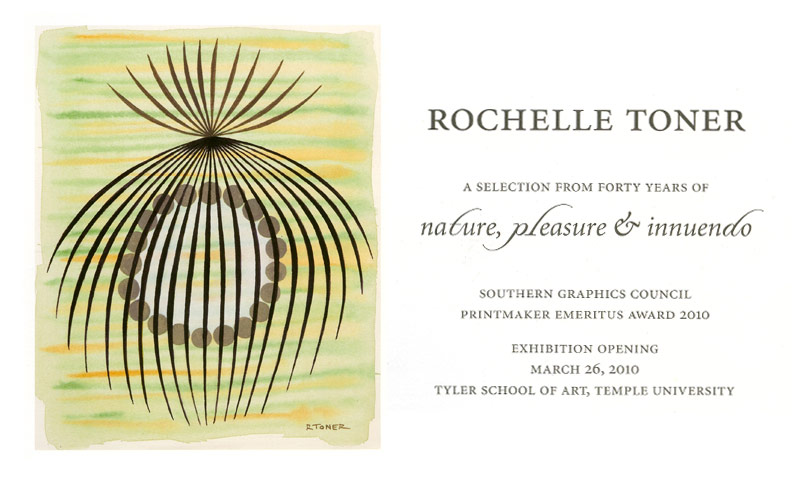
Nature, Pleasure & Innuendo
Contents Under Pressure, an etching from 1972 by the Philadelphia artist Rochelle Toner, presents a tableau of objects, including what could be flayed skin dangling above what appears to be a dangerously spiky cooking surface. This angry Joseph Cornell-like construction is crammed full of information, as are the other etchings in this series of work, all of which are ferocious in both their ambition and their tone. If Cornell’s works can be read as quiet and secretive, these works are hearty proclamations, openly unresolved. And if Toner was showing us her amazing technical chops in these works, she was also laying out a lot of other, more personal, information. The theme of danger as something potentially sexy, which we see here, runs through much of the art in this exhibition, which brings together 90 drawings and prints. Covering over forty years of work, it is a first-rate opportunity to see what has developed over time in Toner’s work, as well as to realize how many things have persisted or reappeared years later.
Contents Under Pressure was made soon after Toner finished graduate school and was teaching at the University of Illinois in Urbana. During those years, she made frequent trips to Chicago where she saw, and was deeply influenced, by exhibitions of several outsider artists including Martin Ramirez and Joseph Yoakum. Their work, with its obsessive mark marking, resonated with Toner, who as a young girl growing up in Iowa had carefully collected the intensely stitched and embroidered [fabric pieces] made by her grandmother. As well as appreciating the often bizarre yard constructions of her father. At the same time, Toner was drawn to Northern Renaissance painters and you can see the meticulous and obsessive details of Jan van Eyck’s paintings are shared in these early etchings.
Without a doubt, however, the Surrealist artists have had the greatest influence on Toner, and that work is something she has mined broadly, from different directions at different times. Toner has said she was “embarrassed by the kookiness of the Surrealists,” but their explorations of sexuality and repression, subjects that she was struggling to bring into her work, were a great resource. Toner has drawn on the Surrealists to create an extended (and still ongoing) exploration of the dynamics of gender and sexuality. We can see this in how she depicts inanimate objects and plant forms, which often take on emotionally charged and human characteristics.
Toner also shares the Surrealist’s fascination with morphing organic forms into abstractions so they hover on the edge of being recognizable. Her subjects become beautiful abstractions while also holding on to their initial thing-ness, reminding us of their connection to reality. Fig Leaf, from 2004, shows a simple iconic outline of a leaf above a complex grouping of less identifiable forms. The intricate shapes are seductively rendered, but their resemblance to slimy underwater plants can not be entirely put out of your mind. These recent etchings are much more open than the earlier ones; not as densely packed and meditative rather than proclamatory. Toner made a series of drawings in the 1980s where the compositions begin harmoniously enough, but then belligerently (and brilliantly) move off the page. The individual parts of these works feel like they are in conversation with each other, rather than unexpectedly (or unhappily) butted up against one another. In the recent etchings, a line might meander, but eventually resolves.
This exhibition includes a number of recent works that the artist calls watercolor drawings. These offer a great opportunity to see the artist quickly moving through themes (in contrast to the process of making an etching, which is quite complex and demands a large commitment from the beginning). Beyond functioning as studies however, these intimate works are wonderful in themselves. Surprisingly diverse, many of them are concentrated, vibrantly-colored organic abstractions, while others are linear abstractions of repeating forms, which do not follow a strict set of rules. Unlike her technically complex etchings, we can directly see how these works came to be.
Toner retired from her position as Dean of Tyler School of Art in 2002 after thirty years of teaching there. This has allowed her to spend more time in her studios in Philadelphia and rural Maryland. Toner shares the dedicated work ethic common to many printmakers, Toner has several projects underway, many of which are demanding and complex etchings. Toner’s work continues to evolve (it is rare to see a fully mature artist continue to be so experimental and expansive in her practice) and we can perhaps see the future path of her work in the series of monoprints she made during a recent residency in Ireland at the Ballinglen Foundation. These simple monoprints with acrylic overpainting are reductive, meditative abstractions of stone walls. Their stripped down modesty are a remarkable departure from previous etchings. The earliest etchings are amazing documents of complexity and vigor, while these new monoprints are a totally different beast: transparent and meditative, but still openly unresolved.
John Caperton, Curator
The Print Center, Philadelphia










